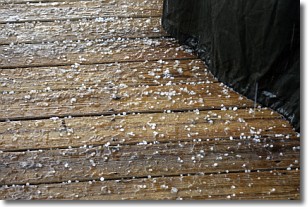Weather Alert in Arizona
Red Flag Warning issued May 13 at 1:31PM MST until May 13 at 8:00PM MST by NWS Tucson AZ
AREAS AFFECTED: Eastern Pima-Southeastern Pinal-Santa Cruz-Western Cochise; Southern Graham-Central and Eastern Cochise-Southern Greenlee-Lower Elevations of the San Carlos Apache Nation in Graham County; Mountains above 5500 feet
DESCRIPTION: ...RED FLAG WARNING REMAINS IN EFFECT FROM 10 AM TO 7 PM MST WEDNESDAY FOR STRONG AND GUSTY WINDS, LOW RELATIVE HUMIDITY, AND HIGH FIRE DANGER FOR FIRE WEATHER ZONES 151, 152, AND 154... * AFFECTED AREA...Fire Weather Zones 151, 152 and 154. * TIMING...For the first Red Flag Warning, until 8 PM MST this evening. For the second Red Flag Warning, from 10 AM to 7 PM MST Wednesday. * WINDS...Southwest 25 to 35 mph with gusts up to 45 mph. * RELATIVE HUMIDITY...As low as 8 percent. * IMPACTS...Any fires that develop or are ongoing will have the potential to spread rapidly.
INSTRUCTION: A Red Flag Warning means that critical fire weather conditions are either occurring now...or are expected to develop. A combination of strong winds...low relative humidity...and dry vegetation will create the potential for rapid and erratic fire growth. Please advise the appropriate officials or fire crews in the field of the Red Flag Warning for portions of Southeast Arizona.
Want more detail? Get the Complete 7 Day and Night Detailed Forecast!
Current U.S. National Radar--Current
The Current National Weather Radar is shown below with a UTC Time (subtract 5 hours from UTC to get Eastern Time).

National Weather Forecast--Current
The Current National Weather Forecast and National Weather Map are shown below.

National Weather Forecast for Tomorrow
Tomorrow National Weather Forecast and Tomorrow National Weather Map are show below.

North America Water Vapor (Moisture)
This map shows recent moisture content over North America. Bright and colored areas show high moisture (ie, clouds); brown indicates very little moisture present; black indicates no moisture.

Weather Topic: What is Rain?
Home - Education - Precipitation - Rain
 Next Topic: Shelf Clouds
Next Topic: Shelf Clouds
Precipitation in the form of water droplets is called rain.
Rain generally has a tendency to fall with less intensity over a greater period
of time, and when rainfall is more severe it is usually less sustained.
Rain is the most common form of precipitation and happens with greater frequency
depending on the season and regional influences. Cities have been shown to have
an observable effect on rainfall, due to an effect called the urban heat island.
Compared to upwind, monthly rainfall between twenty and forty miles downwind of
cities is 30% greater.
Next Topic: Shelf Clouds
Weather Topic: What is Sleet?
Home - Education - Precipitation - Sleet
 Next Topic: Snow
Next Topic: Snow
Sleet is a form of precipitation in which small ice pellets are the primary
components. These ice pellets are smaller and more translucent than hailstones,
and harder than graupel. Sleet is caused by specific atmospheric conditions and
therefore typically doesn't last for extended periods of time.
The condition which leads to sleet formation requires a warmer body of air to be
wedged in between two sub-freezing bodies of air. When snow falls through a warmer
layer of air it melts, and as it falls through the next sub-freezing body of air
it freezes again, forming ice pellets known as sleet. In some cases, water
droplets don't have time to freeze before reaching the surface and the result is
freezing rain.
Next Topic: Snow
Current conditions powered by WeatherAPI.com




